Breastfeeding Policy Analysis
VerifiedAdded on 2023/03/20
|15
|4216
|83
AI Summary
This policy analysis examines the current breastfeeding policies in Australia and the need for revision. It discusses the benefits of breastfeeding for both mother and infant, as well as the current statistics on breastfeeding rates. The analysis highlights the gaps in the existing policies and suggests measures to promote breastfeeding practices.
Contribute Materials
Your contribution can guide someone’s learning journey. Share your
documents today.
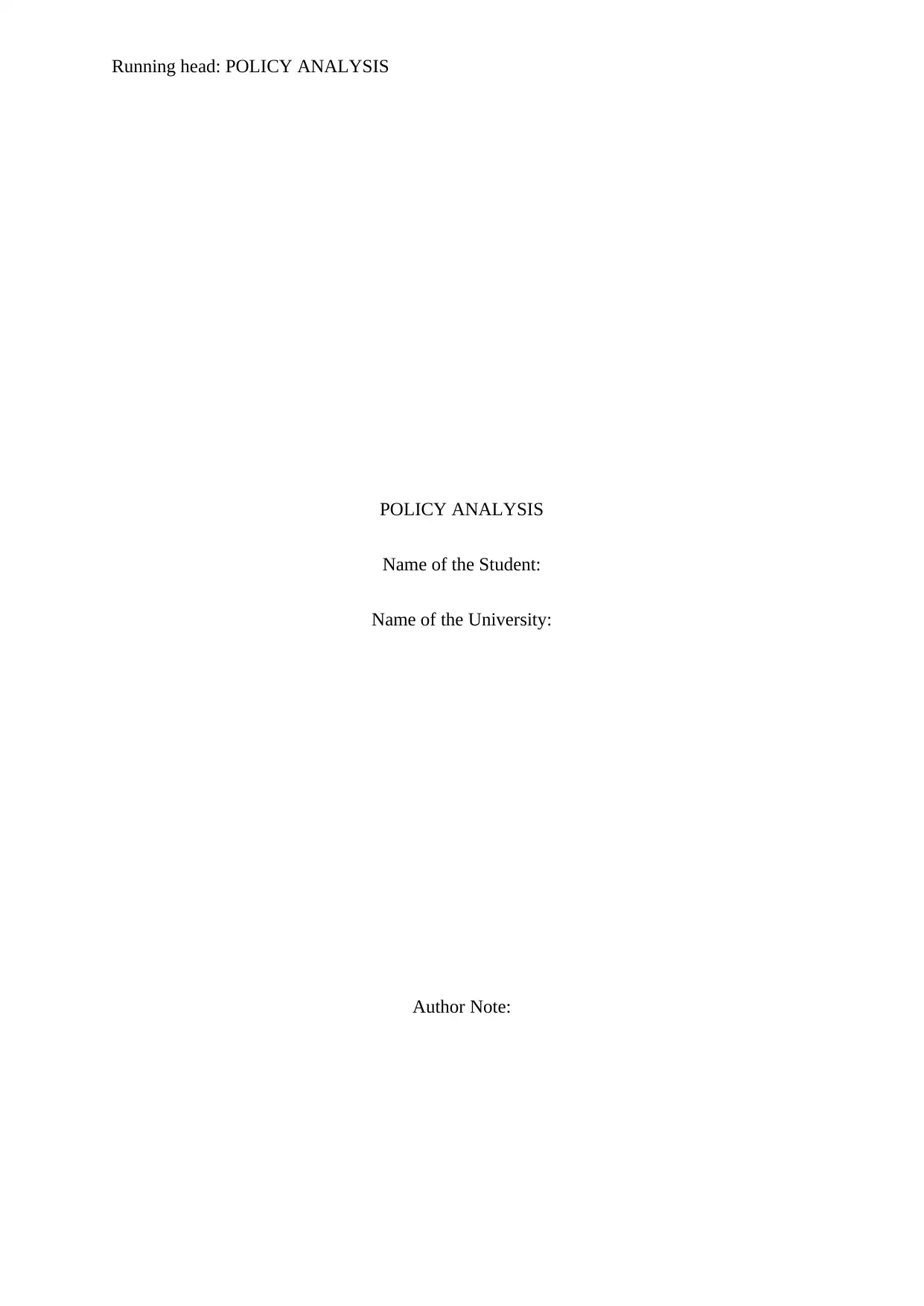
Running head: POLICY ANALYSIS
POLICY ANALYSIS
Name of the Student:
Name of the University:
Author Note:
POLICY ANALYSIS
Name of the Student:
Name of the University:
Author Note:
Secure Best Marks with AI Grader
Need help grading? Try our AI Grader for instant feedback on your assignments.
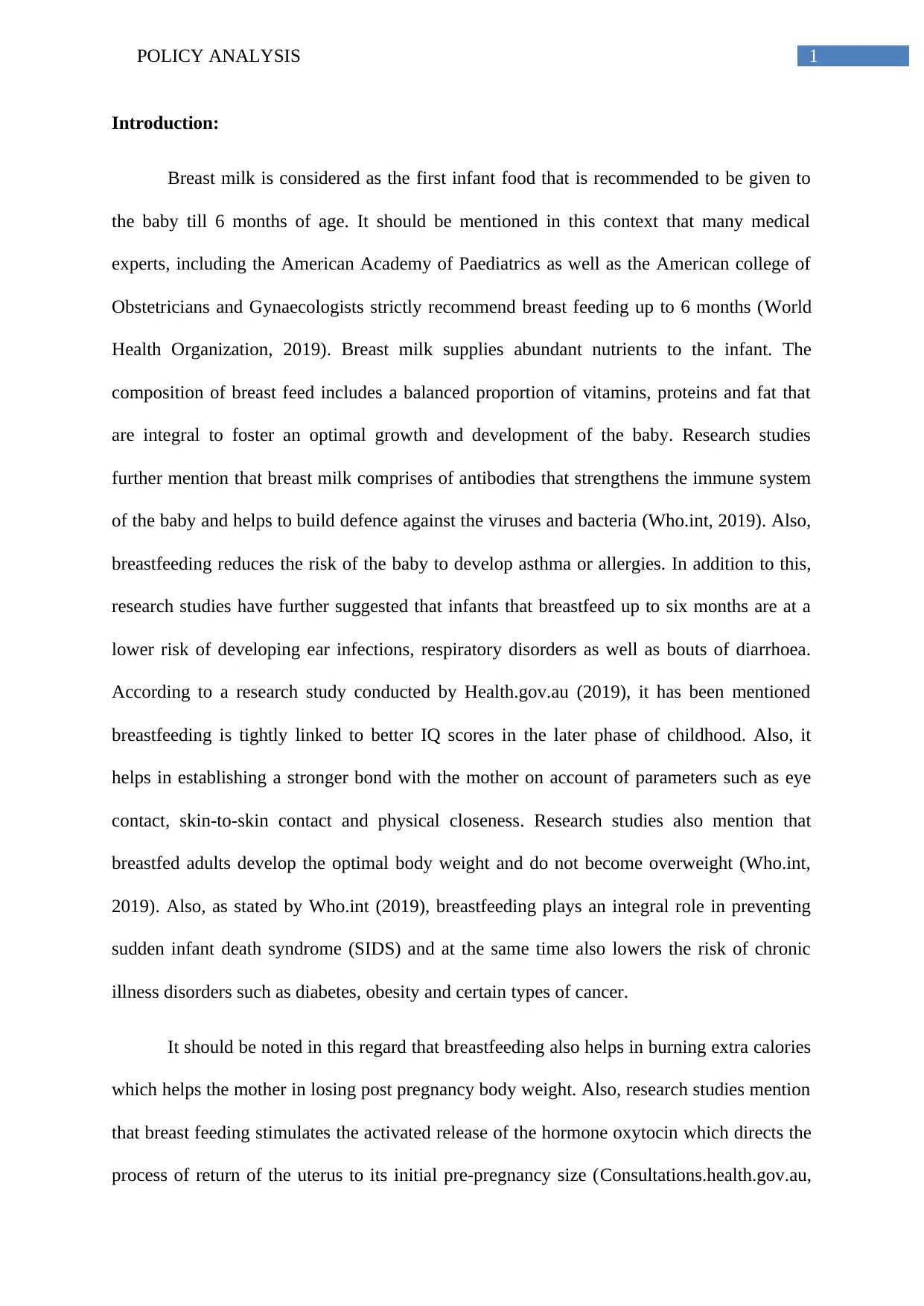
1POLICY ANALYSIS
Introduction:
Breast milk is considered as the first infant food that is recommended to be given to
the baby till 6 months of age. It should be mentioned in this context that many medical
experts, including the American Academy of Paediatrics as well as the American college of
Obstetricians and Gynaecologists strictly recommend breast feeding up to 6 months (World
Health Organization, 2019). Breast milk supplies abundant nutrients to the infant. The
composition of breast feed includes a balanced proportion of vitamins, proteins and fat that
are integral to foster an optimal growth and development of the baby. Research studies
further mention that breast milk comprises of antibodies that strengthens the immune system
of the baby and helps to build defence against the viruses and bacteria (Who.int, 2019). Also,
breastfeeding reduces the risk of the baby to develop asthma or allergies. In addition to this,
research studies have further suggested that infants that breastfeed up to six months are at a
lower risk of developing ear infections, respiratory disorders as well as bouts of diarrhoea.
According to a research study conducted by Health.gov.au (2019), it has been mentioned
breastfeeding is tightly linked to better IQ scores in the later phase of childhood. Also, it
helps in establishing a stronger bond with the mother on account of parameters such as eye
contact, skin-to-skin contact and physical closeness. Research studies also mention that
breastfed adults develop the optimal body weight and do not become overweight (Who.int,
2019). Also, as stated by Who.int (2019), breastfeeding plays an integral role in preventing
sudden infant death syndrome (SIDS) and at the same time also lowers the risk of chronic
illness disorders such as diabetes, obesity and certain types of cancer.
It should be noted in this regard that breastfeeding also helps in burning extra calories
which helps the mother in losing post pregnancy body weight. Also, research studies mention
that breast feeding stimulates the activated release of the hormone oxytocin which directs the
process of return of the uterus to its initial pre-pregnancy size (Consultations.health.gov.au,
Introduction:
Breast milk is considered as the first infant food that is recommended to be given to
the baby till 6 months of age. It should be mentioned in this context that many medical
experts, including the American Academy of Paediatrics as well as the American college of
Obstetricians and Gynaecologists strictly recommend breast feeding up to 6 months (World
Health Organization, 2019). Breast milk supplies abundant nutrients to the infant. The
composition of breast feed includes a balanced proportion of vitamins, proteins and fat that
are integral to foster an optimal growth and development of the baby. Research studies
further mention that breast milk comprises of antibodies that strengthens the immune system
of the baby and helps to build defence against the viruses and bacteria (Who.int, 2019). Also,
breastfeeding reduces the risk of the baby to develop asthma or allergies. In addition to this,
research studies have further suggested that infants that breastfeed up to six months are at a
lower risk of developing ear infections, respiratory disorders as well as bouts of diarrhoea.
According to a research study conducted by Health.gov.au (2019), it has been mentioned
breastfeeding is tightly linked to better IQ scores in the later phase of childhood. Also, it
helps in establishing a stronger bond with the mother on account of parameters such as eye
contact, skin-to-skin contact and physical closeness. Research studies also mention that
breastfed adults develop the optimal body weight and do not become overweight (Who.int,
2019). Also, as stated by Who.int (2019), breastfeeding plays an integral role in preventing
sudden infant death syndrome (SIDS) and at the same time also lowers the risk of chronic
illness disorders such as diabetes, obesity and certain types of cancer.
It should be noted in this regard that breastfeeding also helps in burning extra calories
which helps the mother in losing post pregnancy body weight. Also, research studies mention
that breast feeding stimulates the activated release of the hormone oxytocin which directs the
process of return of the uterus to its initial pre-pregnancy size (Consultations.health.gov.au,
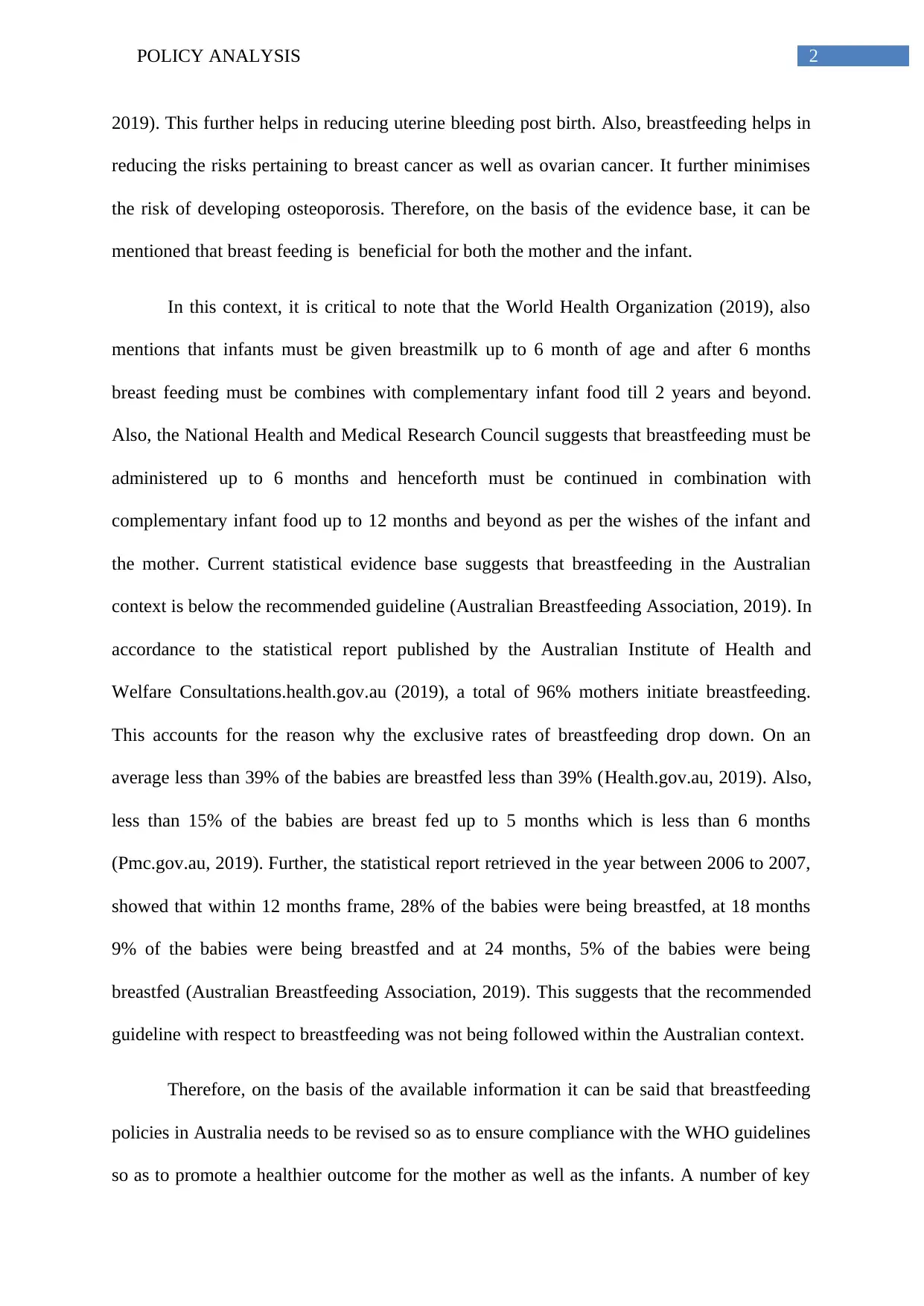
2POLICY ANALYSIS
2019). This further helps in reducing uterine bleeding post birth. Also, breastfeeding helps in
reducing the risks pertaining to breast cancer as well as ovarian cancer. It further minimises
the risk of developing osteoporosis. Therefore, on the basis of the evidence base, it can be
mentioned that breast feeding is beneficial for both the mother and the infant.
In this context, it is critical to note that the World Health Organization (2019), also
mentions that infants must be given breastmilk up to 6 month of age and after 6 months
breast feeding must be combines with complementary infant food till 2 years and beyond.
Also, the National Health and Medical Research Council suggests that breastfeeding must be
administered up to 6 months and henceforth must be continued in combination with
complementary infant food up to 12 months and beyond as per the wishes of the infant and
the mother. Current statistical evidence base suggests that breastfeeding in the Australian
context is below the recommended guideline (Australian Breastfeeding Association, 2019). In
accordance to the statistical report published by the Australian Institute of Health and
Welfare Consultations.health.gov.au (2019), a total of 96% mothers initiate breastfeeding.
This accounts for the reason why the exclusive rates of breastfeeding drop down. On an
average less than 39% of the babies are breastfed less than 39% (Health.gov.au, 2019). Also,
less than 15% of the babies are breast fed up to 5 months which is less than 6 months
(Pmc.gov.au, 2019). Further, the statistical report retrieved in the year between 2006 to 2007,
showed that within 12 months frame, 28% of the babies were being breastfed, at 18 months
9% of the babies were being breastfed and at 24 months, 5% of the babies were being
breastfed (Australian Breastfeeding Association, 2019). This suggests that the recommended
guideline with respect to breastfeeding was not being followed within the Australian context.
Therefore, on the basis of the available information it can be said that breastfeeding
policies in Australia needs to be revised so as to ensure compliance with the WHO guidelines
so as to promote a healthier outcome for the mother as well as the infants. A number of key
2019). This further helps in reducing uterine bleeding post birth. Also, breastfeeding helps in
reducing the risks pertaining to breast cancer as well as ovarian cancer. It further minimises
the risk of developing osteoporosis. Therefore, on the basis of the evidence base, it can be
mentioned that breast feeding is beneficial for both the mother and the infant.
In this context, it is critical to note that the World Health Organization (2019), also
mentions that infants must be given breastmilk up to 6 month of age and after 6 months
breast feeding must be combines with complementary infant food till 2 years and beyond.
Also, the National Health and Medical Research Council suggests that breastfeeding must be
administered up to 6 months and henceforth must be continued in combination with
complementary infant food up to 12 months and beyond as per the wishes of the infant and
the mother. Current statistical evidence base suggests that breastfeeding in the Australian
context is below the recommended guideline (Australian Breastfeeding Association, 2019). In
accordance to the statistical report published by the Australian Institute of Health and
Welfare Consultations.health.gov.au (2019), a total of 96% mothers initiate breastfeeding.
This accounts for the reason why the exclusive rates of breastfeeding drop down. On an
average less than 39% of the babies are breastfed less than 39% (Health.gov.au, 2019). Also,
less than 15% of the babies are breast fed up to 5 months which is less than 6 months
(Pmc.gov.au, 2019). Further, the statistical report retrieved in the year between 2006 to 2007,
showed that within 12 months frame, 28% of the babies were being breastfed, at 18 months
9% of the babies were being breastfed and at 24 months, 5% of the babies were being
breastfed (Australian Breastfeeding Association, 2019). This suggests that the recommended
guideline with respect to breastfeeding was not being followed within the Australian context.
Therefore, on the basis of the available information it can be said that breastfeeding
policies in Australia needs to be revised so as to ensure compliance with the WHO guidelines
so as to promote a healthier outcome for the mother as well as the infants. A number of key
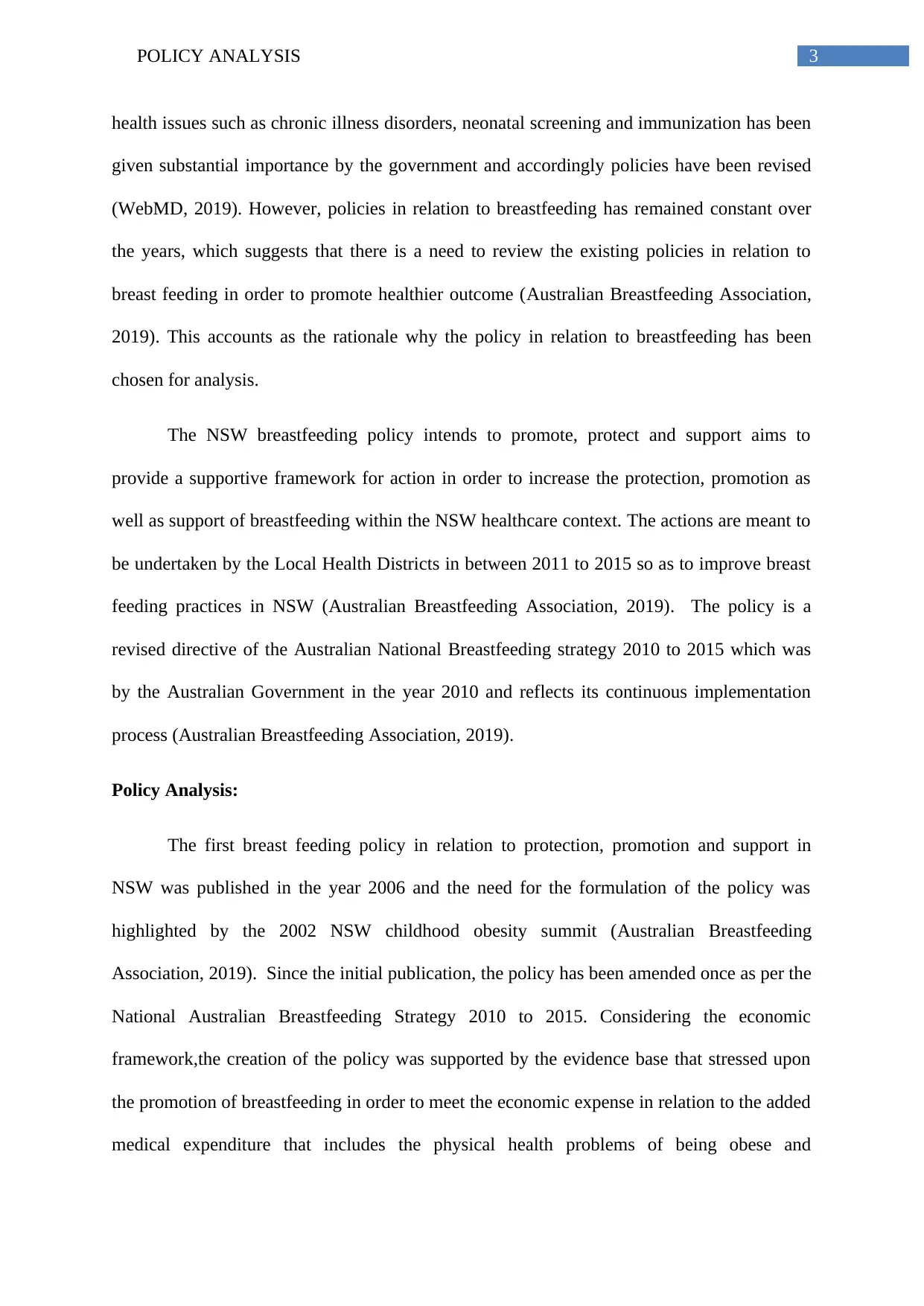
3POLICY ANALYSIS
health issues such as chronic illness disorders, neonatal screening and immunization has been
given substantial importance by the government and accordingly policies have been revised
(WebMD, 2019). However, policies in relation to breastfeeding has remained constant over
the years, which suggests that there is a need to review the existing policies in relation to
breast feeding in order to promote healthier outcome (Australian Breastfeeding Association,
2019). This accounts as the rationale why the policy in relation to breastfeeding has been
chosen for analysis.
The NSW breastfeeding policy intends to promote, protect and support aims to
provide a supportive framework for action in order to increase the protection, promotion as
well as support of breastfeeding within the NSW healthcare context. The actions are meant to
be undertaken by the Local Health Districts in between 2011 to 2015 so as to improve breast
feeding practices in NSW (Australian Breastfeeding Association, 2019). The policy is a
revised directive of the Australian National Breastfeeding strategy 2010 to 2015 which was
by the Australian Government in the year 2010 and reflects its continuous implementation
process (Australian Breastfeeding Association, 2019).
Policy Analysis:
The first breast feeding policy in relation to protection, promotion and support in
NSW was published in the year 2006 and the need for the formulation of the policy was
highlighted by the 2002 NSW childhood obesity summit (Australian Breastfeeding
Association, 2019). Since the initial publication, the policy has been amended once as per the
National Australian Breastfeeding Strategy 2010 to 2015. Considering the economic
framework,the creation of the policy was supported by the evidence base that stressed upon
the promotion of breastfeeding in order to meet the economic expense in relation to the added
medical expenditure that includes the physical health problems of being obese and
health issues such as chronic illness disorders, neonatal screening and immunization has been
given substantial importance by the government and accordingly policies have been revised
(WebMD, 2019). However, policies in relation to breastfeeding has remained constant over
the years, which suggests that there is a need to review the existing policies in relation to
breast feeding in order to promote healthier outcome (Australian Breastfeeding Association,
2019). This accounts as the rationale why the policy in relation to breastfeeding has been
chosen for analysis.
The NSW breastfeeding policy intends to promote, protect and support aims to
provide a supportive framework for action in order to increase the protection, promotion as
well as support of breastfeeding within the NSW healthcare context. The actions are meant to
be undertaken by the Local Health Districts in between 2011 to 2015 so as to improve breast
feeding practices in NSW (Australian Breastfeeding Association, 2019). The policy is a
revised directive of the Australian National Breastfeeding strategy 2010 to 2015 which was
by the Australian Government in the year 2010 and reflects its continuous implementation
process (Australian Breastfeeding Association, 2019).
Policy Analysis:
The first breast feeding policy in relation to protection, promotion and support in
NSW was published in the year 2006 and the need for the formulation of the policy was
highlighted by the 2002 NSW childhood obesity summit (Australian Breastfeeding
Association, 2019). Since the initial publication, the policy has been amended once as per the
National Australian Breastfeeding Strategy 2010 to 2015. Considering the economic
framework,the creation of the policy was supported by the evidence base that stressed upon
the promotion of breastfeeding in order to meet the economic expense in relation to the added
medical expenditure that includes the physical health problems of being obese and
Secure Best Marks with AI Grader
Need help grading? Try our AI Grader for instant feedback on your assignments.
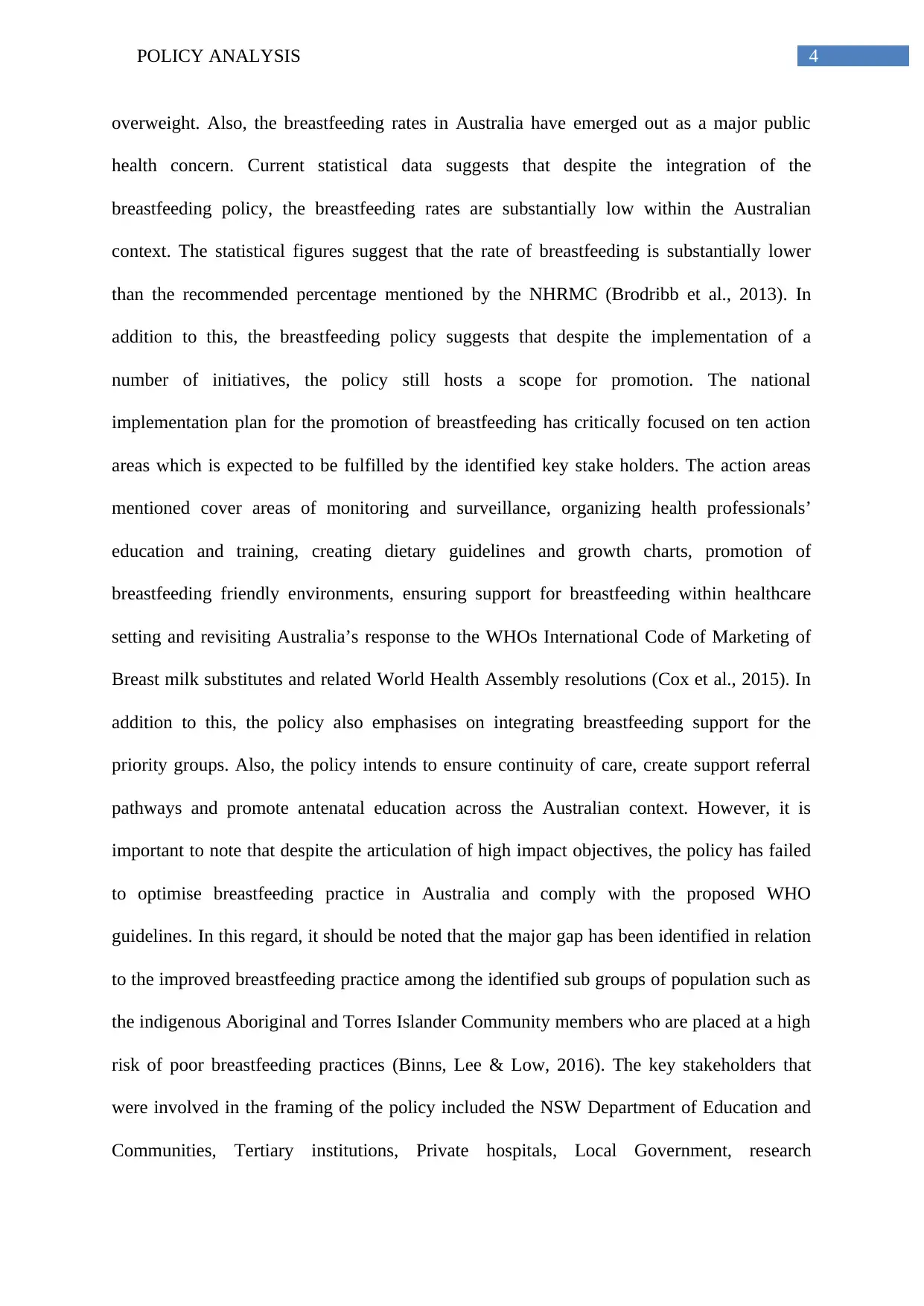
4POLICY ANALYSIS
overweight. Also, the breastfeeding rates in Australia have emerged out as a major public
health concern. Current statistical data suggests that despite the integration of the
breastfeeding policy, the breastfeeding rates are substantially low within the Australian
context. The statistical figures suggest that the rate of breastfeeding is substantially lower
than the recommended percentage mentioned by the NHRMC (Brodribb et al., 2013). In
addition to this, the breastfeeding policy suggests that despite the implementation of a
number of initiatives, the policy still hosts a scope for promotion. The national
implementation plan for the promotion of breastfeeding has critically focused on ten action
areas which is expected to be fulfilled by the identified key stake holders. The action areas
mentioned cover areas of monitoring and surveillance, organizing health professionals’
education and training, creating dietary guidelines and growth charts, promotion of
breastfeeding friendly environments, ensuring support for breastfeeding within healthcare
setting and revisiting Australia’s response to the WHOs International Code of Marketing of
Breast milk substitutes and related World Health Assembly resolutions (Cox et al., 2015). In
addition to this, the policy also emphasises on integrating breastfeeding support for the
priority groups. Also, the policy intends to ensure continuity of care, create support referral
pathways and promote antenatal education across the Australian context. However, it is
important to note that despite the articulation of high impact objectives, the policy has failed
to optimise breastfeeding practice in Australia and comply with the proposed WHO
guidelines. In this regard, it should be noted that the major gap has been identified in relation
to the improved breastfeeding practice among the identified sub groups of population such as
the indigenous Aboriginal and Torres Islander Community members who are placed at a high
risk of poor breastfeeding practices (Binns, Lee & Low, 2016). The key stakeholders that
were involved in the framing of the policy included the NSW Department of Education and
Communities, Tertiary institutions, Private hospitals, Local Government, research
overweight. Also, the breastfeeding rates in Australia have emerged out as a major public
health concern. Current statistical data suggests that despite the integration of the
breastfeeding policy, the breastfeeding rates are substantially low within the Australian
context. The statistical figures suggest that the rate of breastfeeding is substantially lower
than the recommended percentage mentioned by the NHRMC (Brodribb et al., 2013). In
addition to this, the breastfeeding policy suggests that despite the implementation of a
number of initiatives, the policy still hosts a scope for promotion. The national
implementation plan for the promotion of breastfeeding has critically focused on ten action
areas which is expected to be fulfilled by the identified key stake holders. The action areas
mentioned cover areas of monitoring and surveillance, organizing health professionals’
education and training, creating dietary guidelines and growth charts, promotion of
breastfeeding friendly environments, ensuring support for breastfeeding within healthcare
setting and revisiting Australia’s response to the WHOs International Code of Marketing of
Breast milk substitutes and related World Health Assembly resolutions (Cox et al., 2015). In
addition to this, the policy also emphasises on integrating breastfeeding support for the
priority groups. Also, the policy intends to ensure continuity of care, create support referral
pathways and promote antenatal education across the Australian context. However, it is
important to note that despite the articulation of high impact objectives, the policy has failed
to optimise breastfeeding practice in Australia and comply with the proposed WHO
guidelines. In this regard, it should be noted that the major gap has been identified in relation
to the improved breastfeeding practice among the identified sub groups of population such as
the indigenous Aboriginal and Torres Islander Community members who are placed at a high
risk of poor breastfeeding practices (Binns, Lee & Low, 2016). The key stakeholders that
were involved in the framing of the policy included the NSW Department of Education and
Communities, Tertiary institutions, Private hospitals, Local Government, research
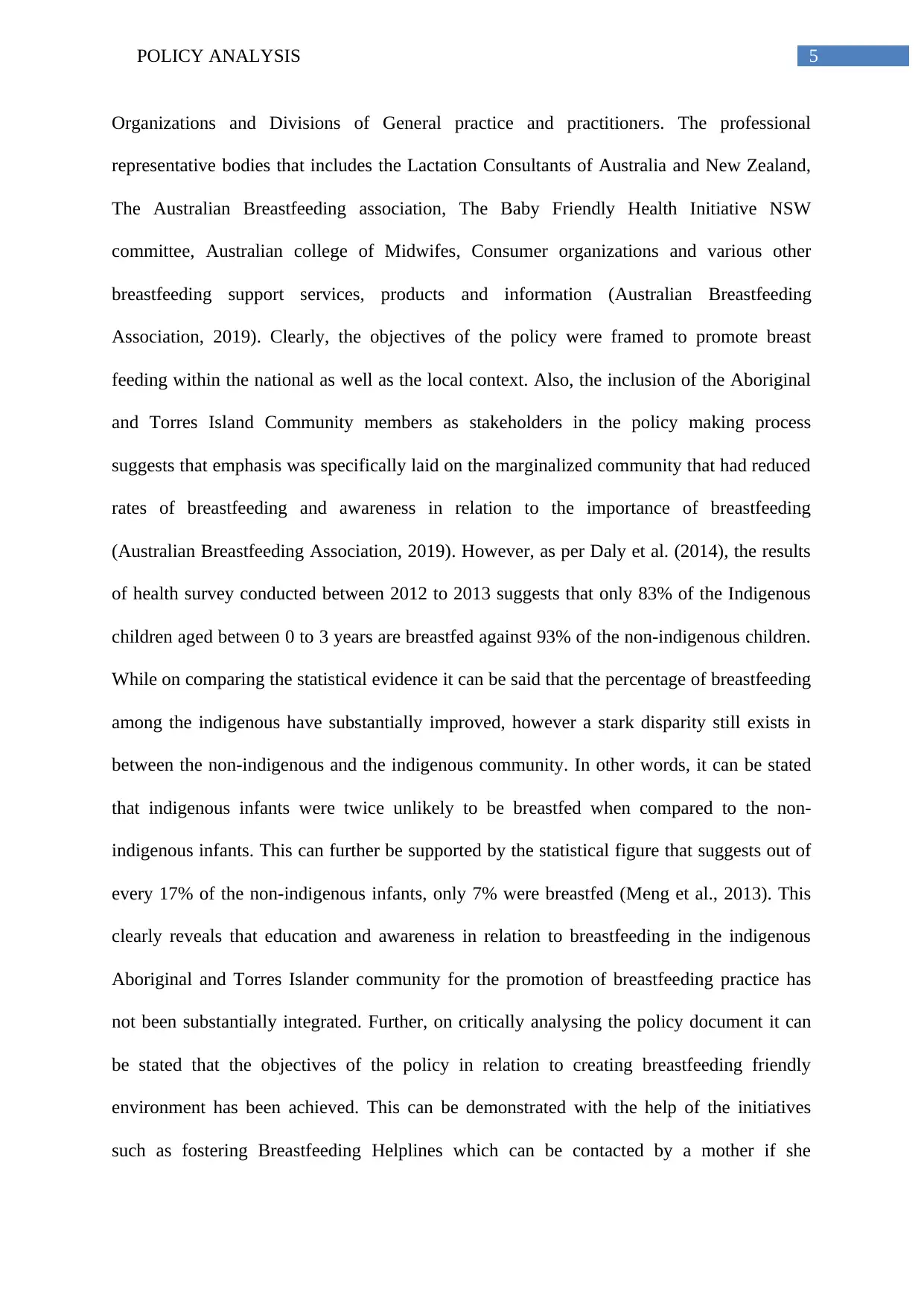
5POLICY ANALYSIS
Organizations and Divisions of General practice and practitioners. The professional
representative bodies that includes the Lactation Consultants of Australia and New Zealand,
The Australian Breastfeeding association, The Baby Friendly Health Initiative NSW
committee, Australian college of Midwifes, Consumer organizations and various other
breastfeeding support services, products and information (Australian Breastfeeding
Association, 2019). Clearly, the objectives of the policy were framed to promote breast
feeding within the national as well as the local context. Also, the inclusion of the Aboriginal
and Torres Island Community members as stakeholders in the policy making process
suggests that emphasis was specifically laid on the marginalized community that had reduced
rates of breastfeeding and awareness in relation to the importance of breastfeeding
(Australian Breastfeeding Association, 2019). However, as per Daly et al. (2014), the results
of health survey conducted between 2012 to 2013 suggests that only 83% of the Indigenous
children aged between 0 to 3 years are breastfed against 93% of the non-indigenous children.
While on comparing the statistical evidence it can be said that the percentage of breastfeeding
among the indigenous have substantially improved, however a stark disparity still exists in
between the non-indigenous and the indigenous community. In other words, it can be stated
that indigenous infants were twice unlikely to be breastfed when compared to the non-
indigenous infants. This can further be supported by the statistical figure that suggests out of
every 17% of the non-indigenous infants, only 7% were breastfed (Meng et al., 2013). This
clearly reveals that education and awareness in relation to breastfeeding in the indigenous
Aboriginal and Torres Islander community for the promotion of breastfeeding practice has
not been substantially integrated. Further, on critically analysing the policy document it can
be stated that the objectives of the policy in relation to creating breastfeeding friendly
environment has been achieved. This can be demonstrated with the help of the initiatives
such as fostering Breastfeeding Helplines which can be contacted by a mother if she
Organizations and Divisions of General practice and practitioners. The professional
representative bodies that includes the Lactation Consultants of Australia and New Zealand,
The Australian Breastfeeding association, The Baby Friendly Health Initiative NSW
committee, Australian college of Midwifes, Consumer organizations and various other
breastfeeding support services, products and information (Australian Breastfeeding
Association, 2019). Clearly, the objectives of the policy were framed to promote breast
feeding within the national as well as the local context. Also, the inclusion of the Aboriginal
and Torres Island Community members as stakeholders in the policy making process
suggests that emphasis was specifically laid on the marginalized community that had reduced
rates of breastfeeding and awareness in relation to the importance of breastfeeding
(Australian Breastfeeding Association, 2019). However, as per Daly et al. (2014), the results
of health survey conducted between 2012 to 2013 suggests that only 83% of the Indigenous
children aged between 0 to 3 years are breastfed against 93% of the non-indigenous children.
While on comparing the statistical evidence it can be said that the percentage of breastfeeding
among the indigenous have substantially improved, however a stark disparity still exists in
between the non-indigenous and the indigenous community. In other words, it can be stated
that indigenous infants were twice unlikely to be breastfed when compared to the non-
indigenous infants. This can further be supported by the statistical figure that suggests out of
every 17% of the non-indigenous infants, only 7% were breastfed (Meng et al., 2013). This
clearly reveals that education and awareness in relation to breastfeeding in the indigenous
Aboriginal and Torres Islander community for the promotion of breastfeeding practice has
not been substantially integrated. Further, on critically analysing the policy document it can
be stated that the objectives of the policy in relation to creating breastfeeding friendly
environment has been achieved. This can be demonstrated with the help of the initiatives
such as fostering Breastfeeding Helplines which can be contacted by a mother if she
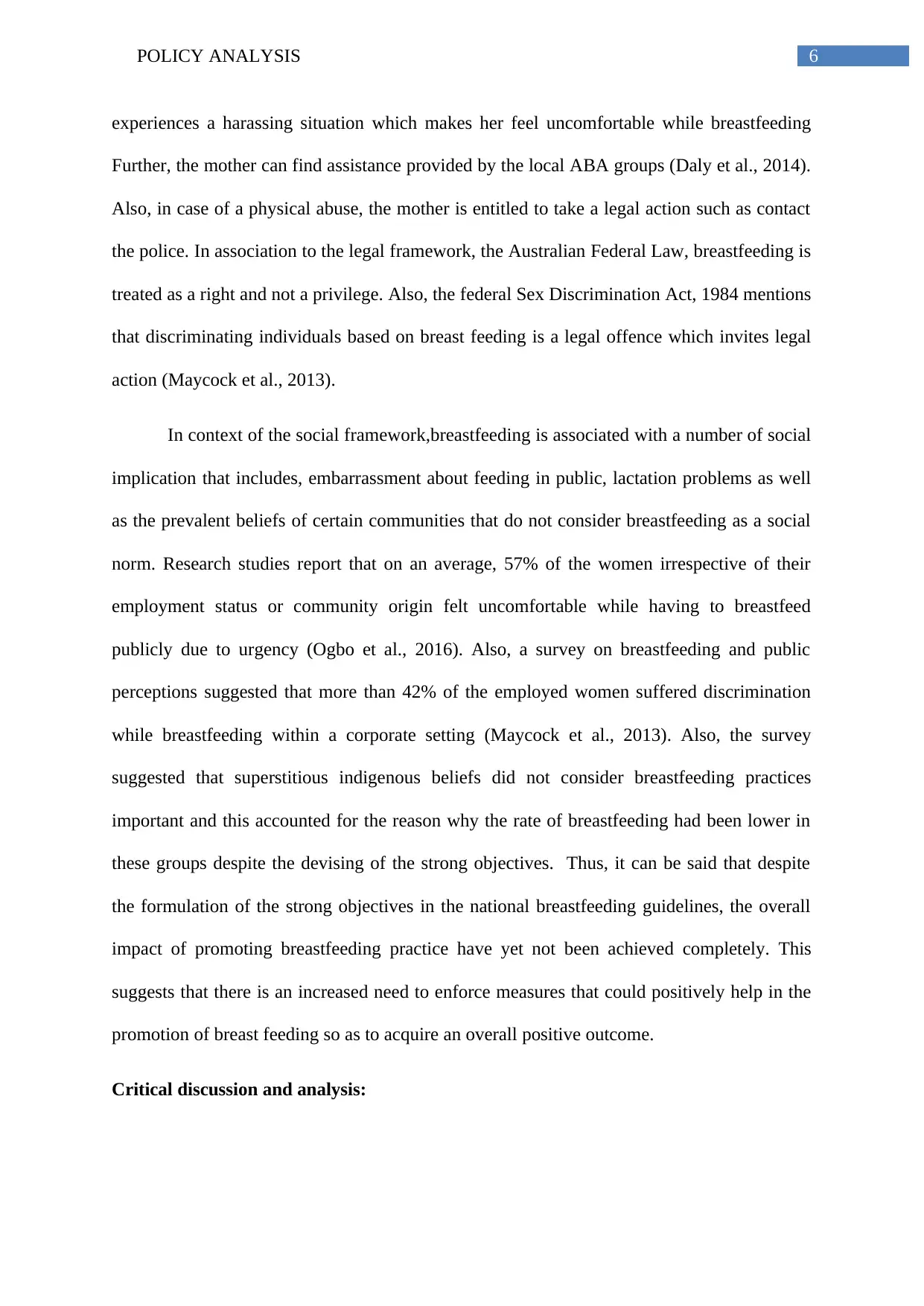
6POLICY ANALYSIS
experiences a harassing situation which makes her feel uncomfortable while breastfeeding
Further, the mother can find assistance provided by the local ABA groups (Daly et al., 2014).
Also, in case of a physical abuse, the mother is entitled to take a legal action such as contact
the police. In association to the legal framework, the Australian Federal Law, breastfeeding is
treated as a right and not a privilege. Also, the federal Sex Discrimination Act, 1984 mentions
that discriminating individuals based on breast feeding is a legal offence which invites legal
action (Maycock et al., 2013).
In context of the social framework,breastfeeding is associated with a number of social
implication that includes, embarrassment about feeding in public, lactation problems as well
as the prevalent beliefs of certain communities that do not consider breastfeeding as a social
norm. Research studies report that on an average, 57% of the women irrespective of their
employment status or community origin felt uncomfortable while having to breastfeed
publicly due to urgency (Ogbo et al., 2016). Also, a survey on breastfeeding and public
perceptions suggested that more than 42% of the employed women suffered discrimination
while breastfeeding within a corporate setting (Maycock et al., 2013). Also, the survey
suggested that superstitious indigenous beliefs did not consider breastfeeding practices
important and this accounted for the reason why the rate of breastfeeding had been lower in
these groups despite the devising of the strong objectives. Thus, it can be said that despite
the formulation of the strong objectives in the national breastfeeding guidelines, the overall
impact of promoting breastfeeding practice have yet not been achieved completely. This
suggests that there is an increased need to enforce measures that could positively help in the
promotion of breast feeding so as to acquire an overall positive outcome.
Critical discussion and analysis:
experiences a harassing situation which makes her feel uncomfortable while breastfeeding
Further, the mother can find assistance provided by the local ABA groups (Daly et al., 2014).
Also, in case of a physical abuse, the mother is entitled to take a legal action such as contact
the police. In association to the legal framework, the Australian Federal Law, breastfeeding is
treated as a right and not a privilege. Also, the federal Sex Discrimination Act, 1984 mentions
that discriminating individuals based on breast feeding is a legal offence which invites legal
action (Maycock et al., 2013).
In context of the social framework,breastfeeding is associated with a number of social
implication that includes, embarrassment about feeding in public, lactation problems as well
as the prevalent beliefs of certain communities that do not consider breastfeeding as a social
norm. Research studies report that on an average, 57% of the women irrespective of their
employment status or community origin felt uncomfortable while having to breastfeed
publicly due to urgency (Ogbo et al., 2016). Also, a survey on breastfeeding and public
perceptions suggested that more than 42% of the employed women suffered discrimination
while breastfeeding within a corporate setting (Maycock et al., 2013). Also, the survey
suggested that superstitious indigenous beliefs did not consider breastfeeding practices
important and this accounted for the reason why the rate of breastfeeding had been lower in
these groups despite the devising of the strong objectives. Thus, it can be said that despite
the formulation of the strong objectives in the national breastfeeding guidelines, the overall
impact of promoting breastfeeding practice have yet not been achieved completely. This
suggests that there is an increased need to enforce measures that could positively help in the
promotion of breast feeding so as to acquire an overall positive outcome.
Critical discussion and analysis:
Paraphrase This Document
Need a fresh take? Get an instant paraphrase of this document with our AI Paraphraser
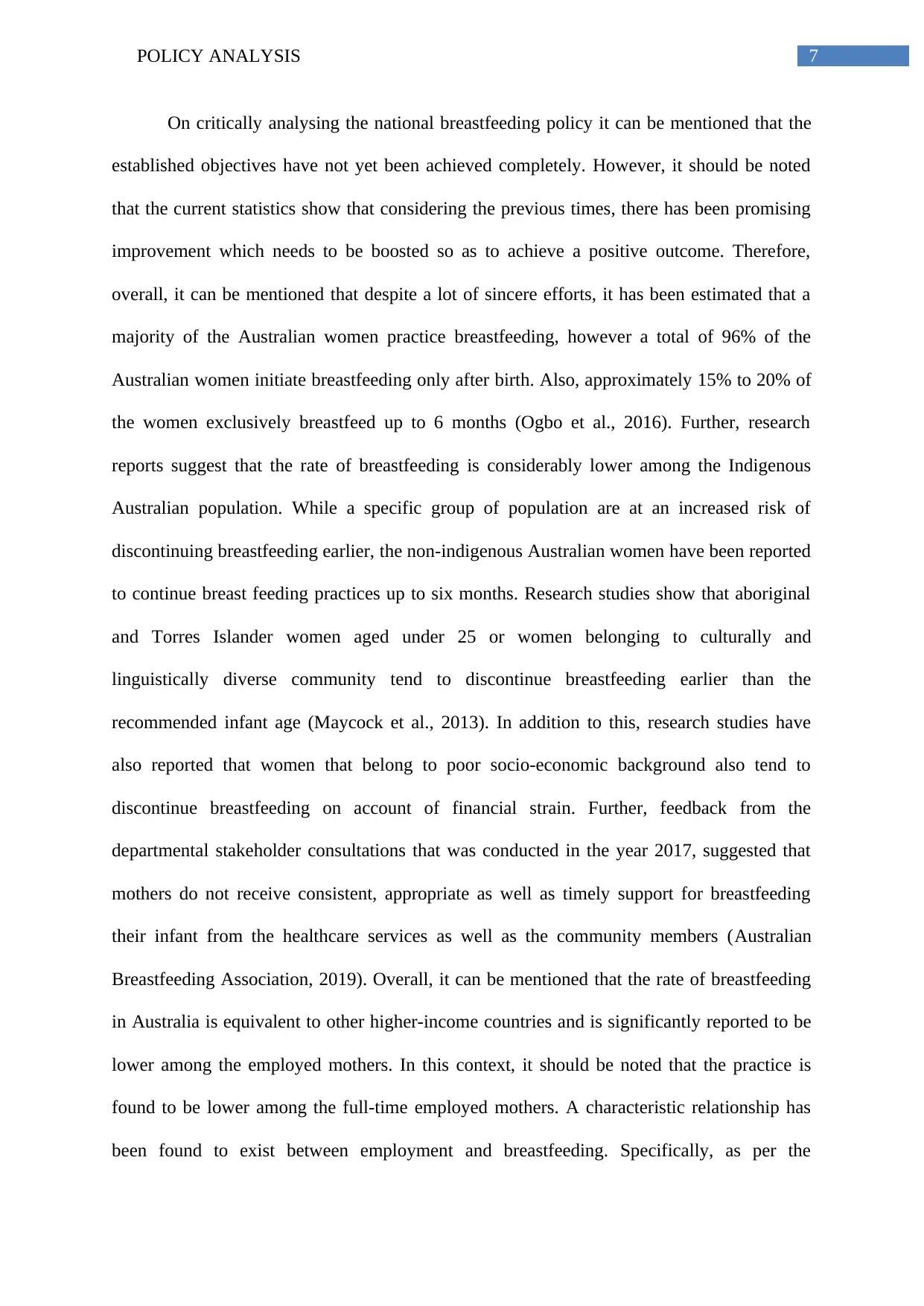
7POLICY ANALYSIS
On critically analysing the national breastfeeding policy it can be mentioned that the
established objectives have not yet been achieved completely. However, it should be noted
that the current statistics show that considering the previous times, there has been promising
improvement which needs to be boosted so as to achieve a positive outcome. Therefore,
overall, it can be mentioned that despite a lot of sincere efforts, it has been estimated that a
majority of the Australian women practice breastfeeding, however a total of 96% of the
Australian women initiate breastfeeding only after birth. Also, approximately 15% to 20% of
the women exclusively breastfeed up to 6 months (Ogbo et al., 2016). Further, research
reports suggest that the rate of breastfeeding is considerably lower among the Indigenous
Australian population. While a specific group of population are at an increased risk of
discontinuing breastfeeding earlier, the non-indigenous Australian women have been reported
to continue breast feeding practices up to six months. Research studies show that aboriginal
and Torres Islander women aged under 25 or women belonging to culturally and
linguistically diverse community tend to discontinue breastfeeding earlier than the
recommended infant age (Maycock et al., 2013). In addition to this, research studies have
also reported that women that belong to poor socio-economic background also tend to
discontinue breastfeeding on account of financial strain. Further, feedback from the
departmental stakeholder consultations that was conducted in the year 2017, suggested that
mothers do not receive consistent, appropriate as well as timely support for breastfeeding
their infant from the healthcare services as well as the community members (Australian
Breastfeeding Association, 2019). Overall, it can be mentioned that the rate of breastfeeding
in Australia is equivalent to other higher-income countries and is significantly reported to be
lower among the employed mothers. In this context, it should be noted that the practice is
found to be lower among the full-time employed mothers. A characteristic relationship has
been found to exist between employment and breastfeeding. Specifically, as per the
On critically analysing the national breastfeeding policy it can be mentioned that the
established objectives have not yet been achieved completely. However, it should be noted
that the current statistics show that considering the previous times, there has been promising
improvement which needs to be boosted so as to achieve a positive outcome. Therefore,
overall, it can be mentioned that despite a lot of sincere efforts, it has been estimated that a
majority of the Australian women practice breastfeeding, however a total of 96% of the
Australian women initiate breastfeeding only after birth. Also, approximately 15% to 20% of
the women exclusively breastfeed up to 6 months (Ogbo et al., 2016). Further, research
reports suggest that the rate of breastfeeding is considerably lower among the Indigenous
Australian population. While a specific group of population are at an increased risk of
discontinuing breastfeeding earlier, the non-indigenous Australian women have been reported
to continue breast feeding practices up to six months. Research studies show that aboriginal
and Torres Islander women aged under 25 or women belonging to culturally and
linguistically diverse community tend to discontinue breastfeeding earlier than the
recommended infant age (Maycock et al., 2013). In addition to this, research studies have
also reported that women that belong to poor socio-economic background also tend to
discontinue breastfeeding on account of financial strain. Further, feedback from the
departmental stakeholder consultations that was conducted in the year 2017, suggested that
mothers do not receive consistent, appropriate as well as timely support for breastfeeding
their infant from the healthcare services as well as the community members (Australian
Breastfeeding Association, 2019). Overall, it can be mentioned that the rate of breastfeeding
in Australia is equivalent to other higher-income countries and is significantly reported to be
lower among the employed mothers. In this context, it should be noted that the practice is
found to be lower among the full-time employed mothers. A characteristic relationship has
been found to exist between employment and breastfeeding. Specifically, as per the
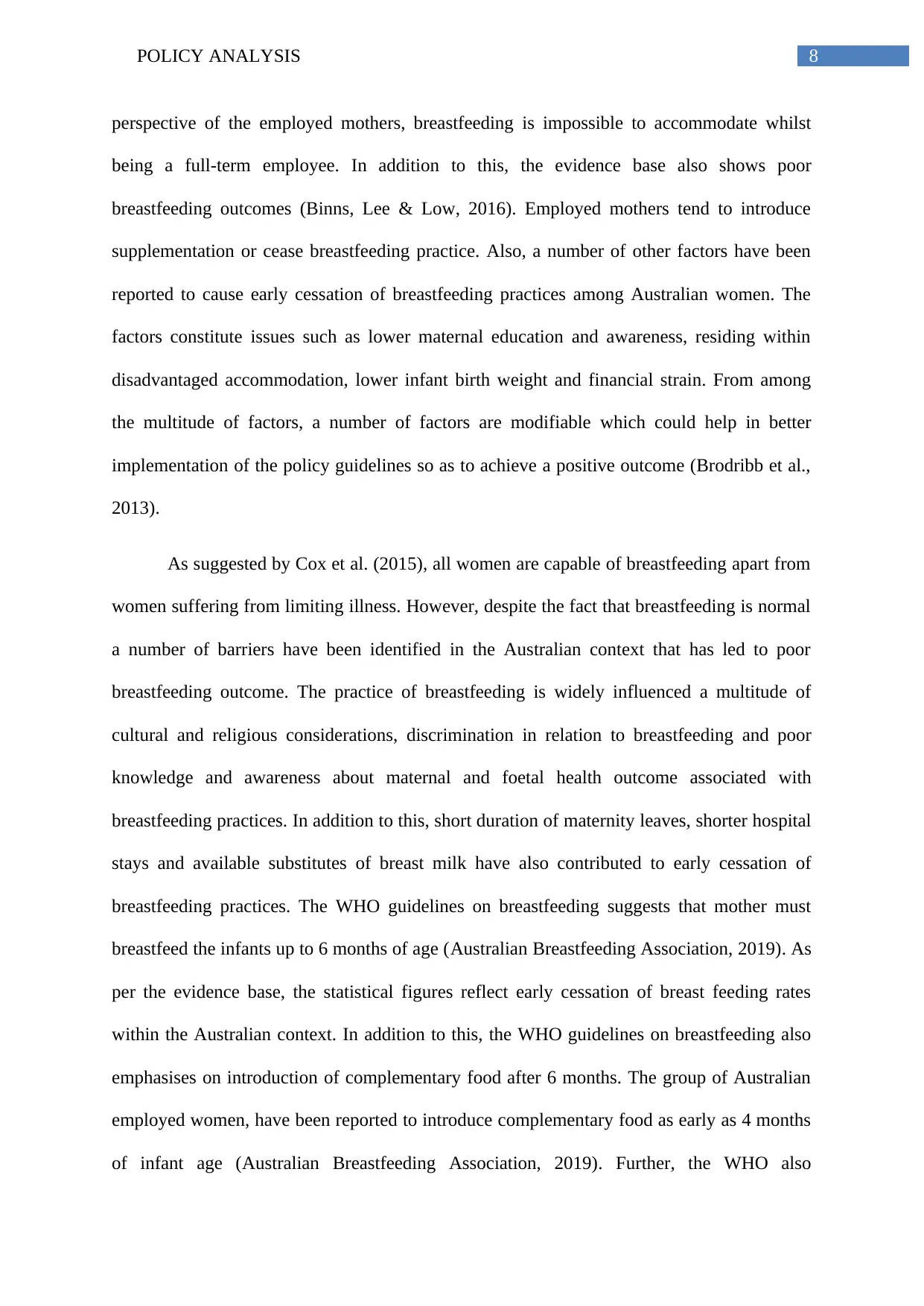
8POLICY ANALYSIS
perspective of the employed mothers, breastfeeding is impossible to accommodate whilst
being a full-term employee. In addition to this, the evidence base also shows poor
breastfeeding outcomes (Binns, Lee & Low, 2016). Employed mothers tend to introduce
supplementation or cease breastfeeding practice. Also, a number of other factors have been
reported to cause early cessation of breastfeeding practices among Australian women. The
factors constitute issues such as lower maternal education and awareness, residing within
disadvantaged accommodation, lower infant birth weight and financial strain. From among
the multitude of factors, a number of factors are modifiable which could help in better
implementation of the policy guidelines so as to achieve a positive outcome (Brodribb et al.,
2013).
As suggested by Cox et al. (2015), all women are capable of breastfeeding apart from
women suffering from limiting illness. However, despite the fact that breastfeeding is normal
a number of barriers have been identified in the Australian context that has led to poor
breastfeeding outcome. The practice of breastfeeding is widely influenced a multitude of
cultural and religious considerations, discrimination in relation to breastfeeding and poor
knowledge and awareness about maternal and foetal health outcome associated with
breastfeeding practices. In addition to this, short duration of maternity leaves, shorter hospital
stays and available substitutes of breast milk have also contributed to early cessation of
breastfeeding practices. The WHO guidelines on breastfeeding suggests that mother must
breastfeed the infants up to 6 months of age (Australian Breastfeeding Association, 2019). As
per the evidence base, the statistical figures reflect early cessation of breast feeding rates
within the Australian context. In addition to this, the WHO guidelines on breastfeeding also
emphasises on introduction of complementary food after 6 months. The group of Australian
employed women, have been reported to introduce complementary food as early as 4 months
of infant age (Australian Breastfeeding Association, 2019). Further, the WHO also
perspective of the employed mothers, breastfeeding is impossible to accommodate whilst
being a full-term employee. In addition to this, the evidence base also shows poor
breastfeeding outcomes (Binns, Lee & Low, 2016). Employed mothers tend to introduce
supplementation or cease breastfeeding practice. Also, a number of other factors have been
reported to cause early cessation of breastfeeding practices among Australian women. The
factors constitute issues such as lower maternal education and awareness, residing within
disadvantaged accommodation, lower infant birth weight and financial strain. From among
the multitude of factors, a number of factors are modifiable which could help in better
implementation of the policy guidelines so as to achieve a positive outcome (Brodribb et al.,
2013).
As suggested by Cox et al. (2015), all women are capable of breastfeeding apart from
women suffering from limiting illness. However, despite the fact that breastfeeding is normal
a number of barriers have been identified in the Australian context that has led to poor
breastfeeding outcome. The practice of breastfeeding is widely influenced a multitude of
cultural and religious considerations, discrimination in relation to breastfeeding and poor
knowledge and awareness about maternal and foetal health outcome associated with
breastfeeding practices. In addition to this, short duration of maternity leaves, shorter hospital
stays and available substitutes of breast milk have also contributed to early cessation of
breastfeeding practices. The WHO guidelines on breastfeeding suggests that mother must
breastfeed the infants up to 6 months of age (Australian Breastfeeding Association, 2019). As
per the evidence base, the statistical figures reflect early cessation of breast feeding rates
within the Australian context. In addition to this, the WHO guidelines on breastfeeding also
emphasises on introduction of complementary food after 6 months. The group of Australian
employed women, have been reported to introduce complementary food as early as 4 months
of infant age (Australian Breastfeeding Association, 2019). Further, the WHO also
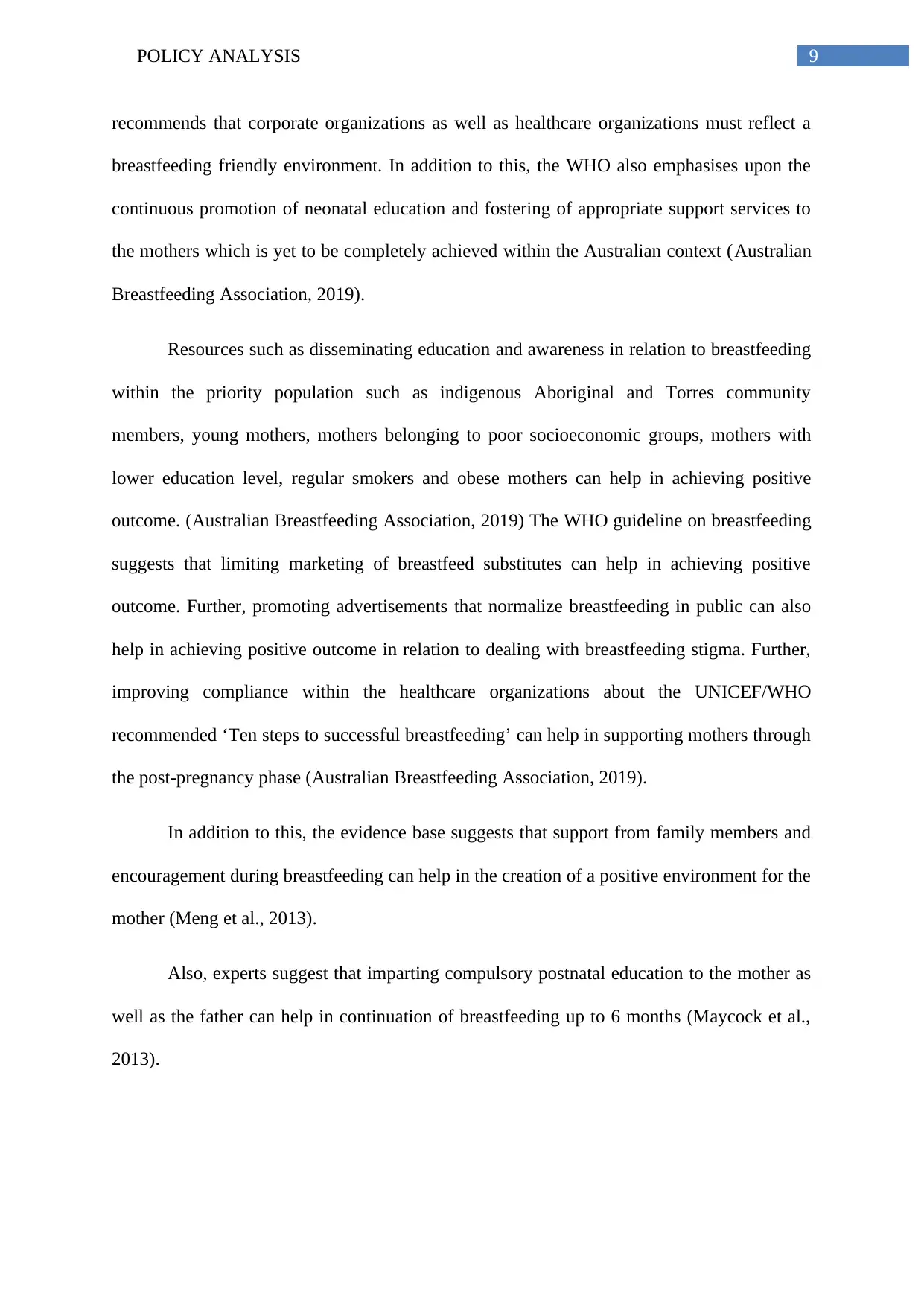
9POLICY ANALYSIS
recommends that corporate organizations as well as healthcare organizations must reflect a
breastfeeding friendly environment. In addition to this, the WHO also emphasises upon the
continuous promotion of neonatal education and fostering of appropriate support services to
the mothers which is yet to be completely achieved within the Australian context (Australian
Breastfeeding Association, 2019).
Resources such as disseminating education and awareness in relation to breastfeeding
within the priority population such as indigenous Aboriginal and Torres community
members, young mothers, mothers belonging to poor socioeconomic groups, mothers with
lower education level, regular smokers and obese mothers can help in achieving positive
outcome. (Australian Breastfeeding Association, 2019) The WHO guideline on breastfeeding
suggests that limiting marketing of breastfeed substitutes can help in achieving positive
outcome. Further, promoting advertisements that normalize breastfeeding in public can also
help in achieving positive outcome in relation to dealing with breastfeeding stigma. Further,
improving compliance within the healthcare organizations about the UNICEF/WHO
recommended ‘Ten steps to successful breastfeeding’ can help in supporting mothers through
the post-pregnancy phase (Australian Breastfeeding Association, 2019).
In addition to this, the evidence base suggests that support from family members and
encouragement during breastfeeding can help in the creation of a positive environment for the
mother (Meng et al., 2013).
Also, experts suggest that imparting compulsory postnatal education to the mother as
well as the father can help in continuation of breastfeeding up to 6 months (Maycock et al.,
2013).
recommends that corporate organizations as well as healthcare organizations must reflect a
breastfeeding friendly environment. In addition to this, the WHO also emphasises upon the
continuous promotion of neonatal education and fostering of appropriate support services to
the mothers which is yet to be completely achieved within the Australian context (Australian
Breastfeeding Association, 2019).
Resources such as disseminating education and awareness in relation to breastfeeding
within the priority population such as indigenous Aboriginal and Torres community
members, young mothers, mothers belonging to poor socioeconomic groups, mothers with
lower education level, regular smokers and obese mothers can help in achieving positive
outcome. (Australian Breastfeeding Association, 2019) The WHO guideline on breastfeeding
suggests that limiting marketing of breastfeed substitutes can help in achieving positive
outcome. Further, promoting advertisements that normalize breastfeeding in public can also
help in achieving positive outcome in relation to dealing with breastfeeding stigma. Further,
improving compliance within the healthcare organizations about the UNICEF/WHO
recommended ‘Ten steps to successful breastfeeding’ can help in supporting mothers through
the post-pregnancy phase (Australian Breastfeeding Association, 2019).
In addition to this, the evidence base suggests that support from family members and
encouragement during breastfeeding can help in the creation of a positive environment for the
mother (Meng et al., 2013).
Also, experts suggest that imparting compulsory postnatal education to the mother as
well as the father can help in continuation of breastfeeding up to 6 months (Maycock et al.,
2013).
Secure Best Marks with AI Grader
Need help grading? Try our AI Grader for instant feedback on your assignments.
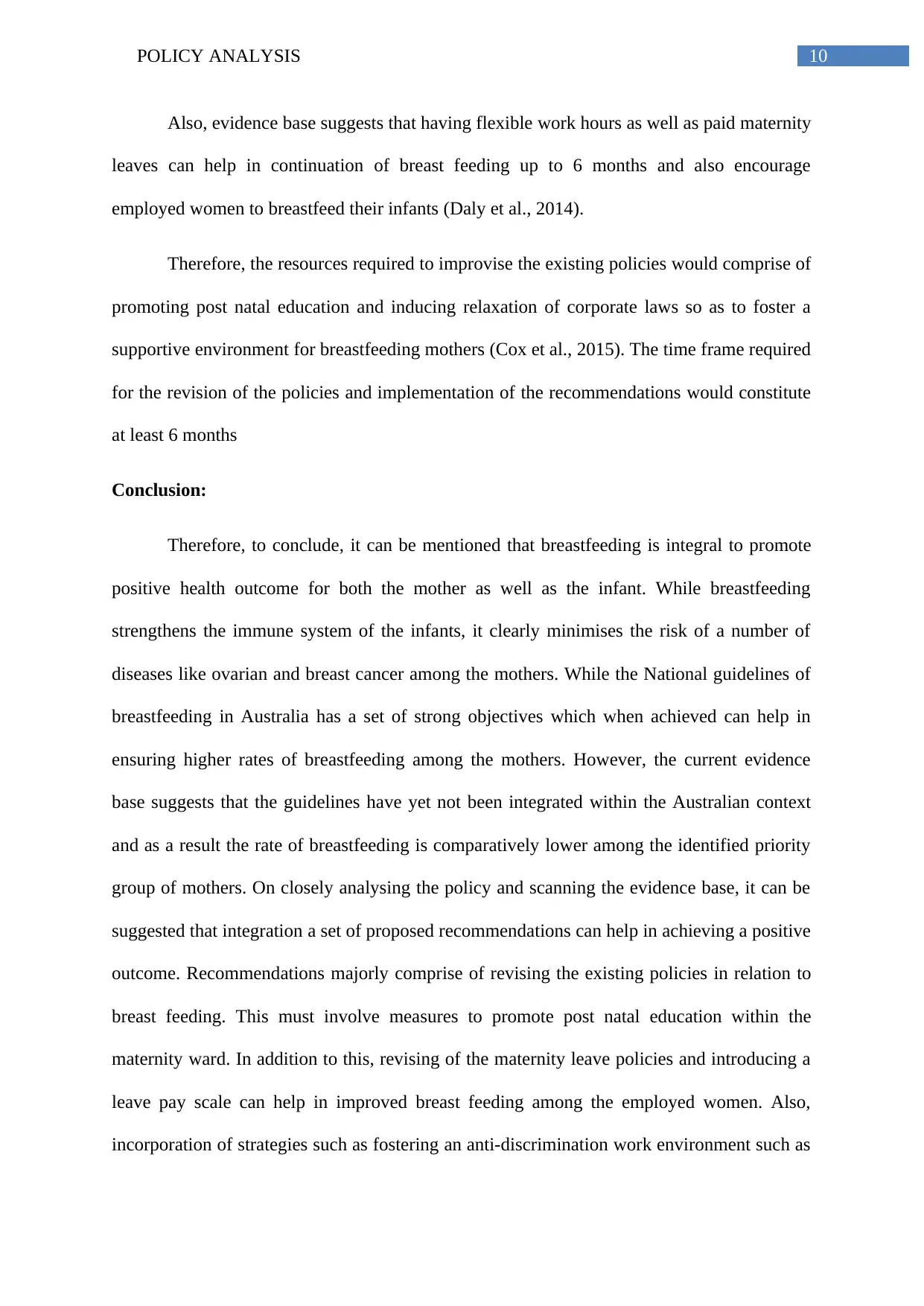
10POLICY ANALYSIS
Also, evidence base suggests that having flexible work hours as well as paid maternity
leaves can help in continuation of breast feeding up to 6 months and also encourage
employed women to breastfeed their infants (Daly et al., 2014).
Therefore, the resources required to improvise the existing policies would comprise of
promoting post natal education and inducing relaxation of corporate laws so as to foster a
supportive environment for breastfeeding mothers (Cox et al., 2015). The time frame required
for the revision of the policies and implementation of the recommendations would constitute
at least 6 months
Conclusion:
Therefore, to conclude, it can be mentioned that breastfeeding is integral to promote
positive health outcome for both the mother as well as the infant. While breastfeeding
strengthens the immune system of the infants, it clearly minimises the risk of a number of
diseases like ovarian and breast cancer among the mothers. While the National guidelines of
breastfeeding in Australia has a set of strong objectives which when achieved can help in
ensuring higher rates of breastfeeding among the mothers. However, the current evidence
base suggests that the guidelines have yet not been integrated within the Australian context
and as a result the rate of breastfeeding is comparatively lower among the identified priority
group of mothers. On closely analysing the policy and scanning the evidence base, it can be
suggested that integration a set of proposed recommendations can help in achieving a positive
outcome. Recommendations majorly comprise of revising the existing policies in relation to
breast feeding. This must involve measures to promote post natal education within the
maternity ward. In addition to this, revising of the maternity leave policies and introducing a
leave pay scale can help in improved breast feeding among the employed women. Also,
incorporation of strategies such as fostering an anti-discrimination work environment such as
Also, evidence base suggests that having flexible work hours as well as paid maternity
leaves can help in continuation of breast feeding up to 6 months and also encourage
employed women to breastfeed their infants (Daly et al., 2014).
Therefore, the resources required to improvise the existing policies would comprise of
promoting post natal education and inducing relaxation of corporate laws so as to foster a
supportive environment for breastfeeding mothers (Cox et al., 2015). The time frame required
for the revision of the policies and implementation of the recommendations would constitute
at least 6 months
Conclusion:
Therefore, to conclude, it can be mentioned that breastfeeding is integral to promote
positive health outcome for both the mother as well as the infant. While breastfeeding
strengthens the immune system of the infants, it clearly minimises the risk of a number of
diseases like ovarian and breast cancer among the mothers. While the National guidelines of
breastfeeding in Australia has a set of strong objectives which when achieved can help in
ensuring higher rates of breastfeeding among the mothers. However, the current evidence
base suggests that the guidelines have yet not been integrated within the Australian context
and as a result the rate of breastfeeding is comparatively lower among the identified priority
group of mothers. On closely analysing the policy and scanning the evidence base, it can be
suggested that integration a set of proposed recommendations can help in achieving a positive
outcome. Recommendations majorly comprise of revising the existing policies in relation to
breast feeding. This must involve measures to promote post natal education within the
maternity ward. In addition to this, revising of the maternity leave policies and introducing a
leave pay scale can help in improved breast feeding among the employed women. Also,
incorporation of strategies such as fostering an anti-discrimination work environment such as
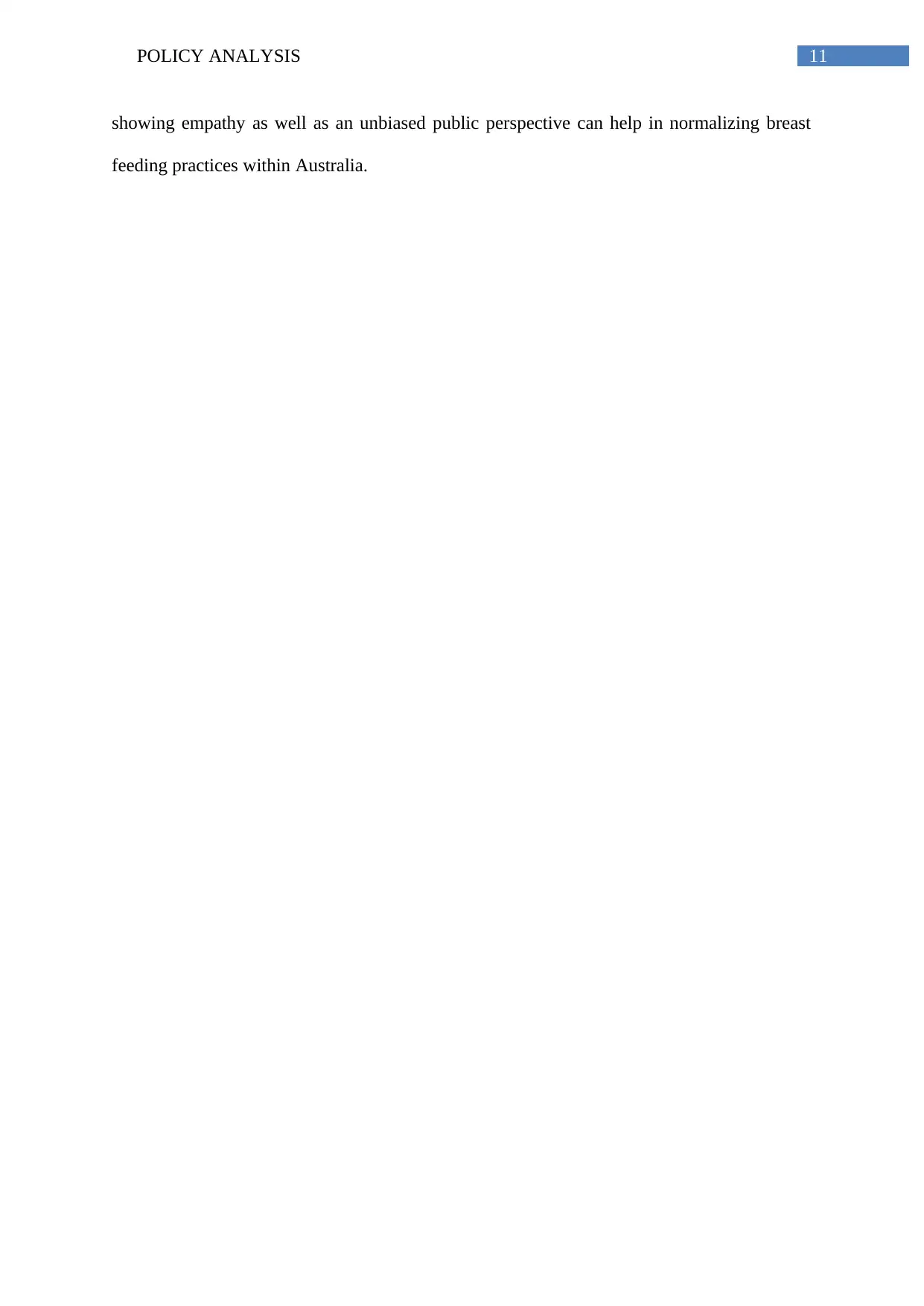
11POLICY ANALYSIS
showing empathy as well as an unbiased public perspective can help in normalizing breast
feeding practices within Australia.
showing empathy as well as an unbiased public perspective can help in normalizing breast
feeding practices within Australia.
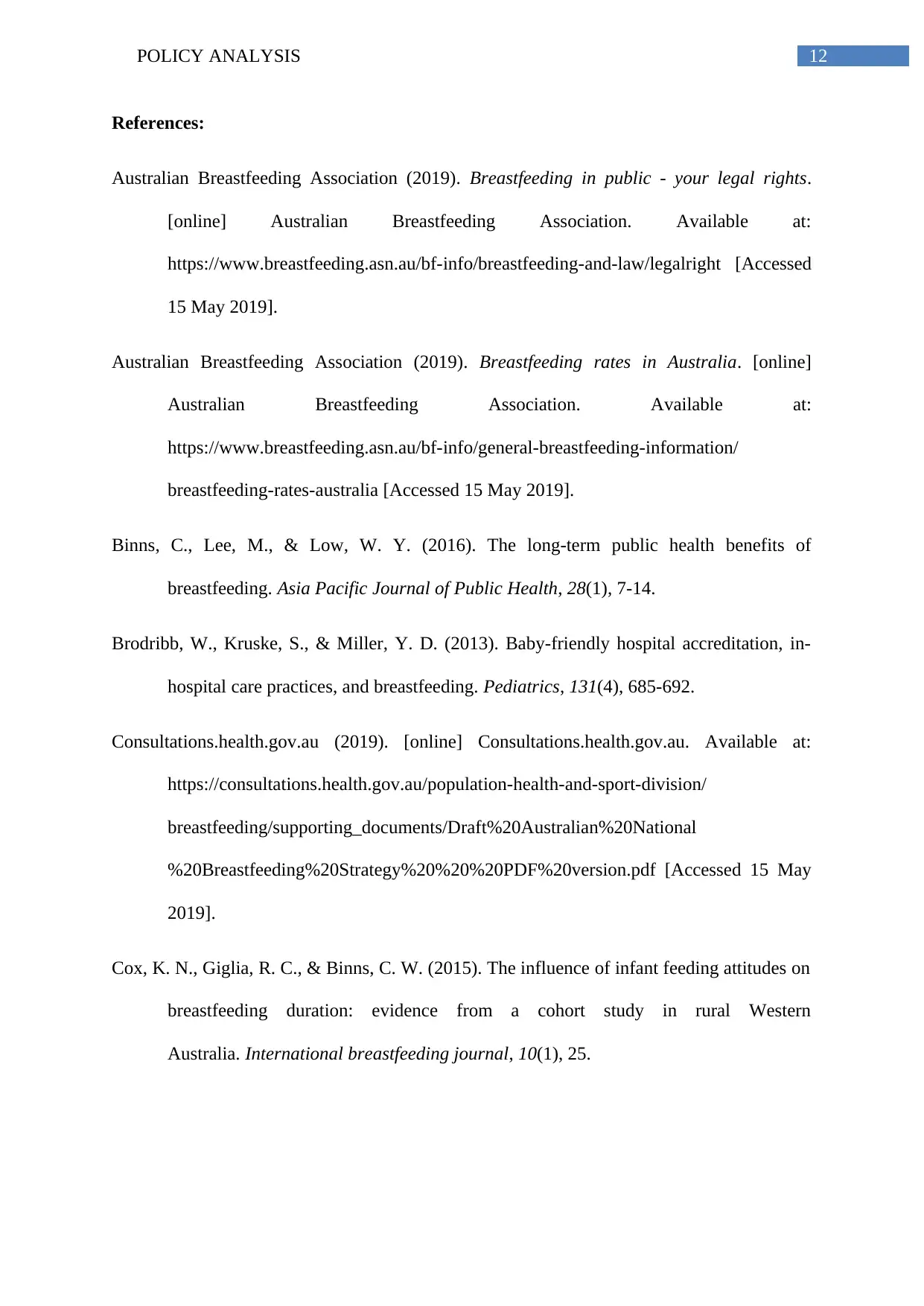
12POLICY ANALYSIS
References:
Australian Breastfeeding Association (2019). Breastfeeding in public - your legal rights.
[online] Australian Breastfeeding Association. Available at:
https://www.breastfeeding.asn.au/bf-info/breastfeeding-and-law/legalright [Accessed
15 May 2019].
Australian Breastfeeding Association (2019). Breastfeeding rates in Australia. [online]
Australian Breastfeeding Association. Available at:
https://www.breastfeeding.asn.au/bf-info/general-breastfeeding-information/
breastfeeding-rates-australia [Accessed 15 May 2019].
Binns, C., Lee, M., & Low, W. Y. (2016). The long-term public health benefits of
breastfeeding. Asia Pacific Journal of Public Health, 28(1), 7-14.
Brodribb, W., Kruske, S., & Miller, Y. D. (2013). Baby-friendly hospital accreditation, in-
hospital care practices, and breastfeeding. Pediatrics, 131(4), 685-692.
Consultations.health.gov.au (2019). [online] Consultations.health.gov.au. Available at:
https://consultations.health.gov.au/population-health-and-sport-division/
breastfeeding/supporting_documents/Draft%20Australian%20National
%20Breastfeeding%20Strategy%20%20%20PDF%20version.pdf [Accessed 15 May
2019].
Cox, K. N., Giglia, R. C., & Binns, C. W. (2015). The influence of infant feeding attitudes on
breastfeeding duration: evidence from a cohort study in rural Western
Australia. International breastfeeding journal, 10(1), 25.
References:
Australian Breastfeeding Association (2019). Breastfeeding in public - your legal rights.
[online] Australian Breastfeeding Association. Available at:
https://www.breastfeeding.asn.au/bf-info/breastfeeding-and-law/legalright [Accessed
15 May 2019].
Australian Breastfeeding Association (2019). Breastfeeding rates in Australia. [online]
Australian Breastfeeding Association. Available at:
https://www.breastfeeding.asn.au/bf-info/general-breastfeeding-information/
breastfeeding-rates-australia [Accessed 15 May 2019].
Binns, C., Lee, M., & Low, W. Y. (2016). The long-term public health benefits of
breastfeeding. Asia Pacific Journal of Public Health, 28(1), 7-14.
Brodribb, W., Kruske, S., & Miller, Y. D. (2013). Baby-friendly hospital accreditation, in-
hospital care practices, and breastfeeding. Pediatrics, 131(4), 685-692.
Consultations.health.gov.au (2019). [online] Consultations.health.gov.au. Available at:
https://consultations.health.gov.au/population-health-and-sport-division/
breastfeeding/supporting_documents/Draft%20Australian%20National
%20Breastfeeding%20Strategy%20%20%20PDF%20version.pdf [Accessed 15 May
2019].
Cox, K. N., Giglia, R. C., & Binns, C. W. (2015). The influence of infant feeding attitudes on
breastfeeding duration: evidence from a cohort study in rural Western
Australia. International breastfeeding journal, 10(1), 25.
Paraphrase This Document
Need a fresh take? Get an instant paraphrase of this document with our AI Paraphraser
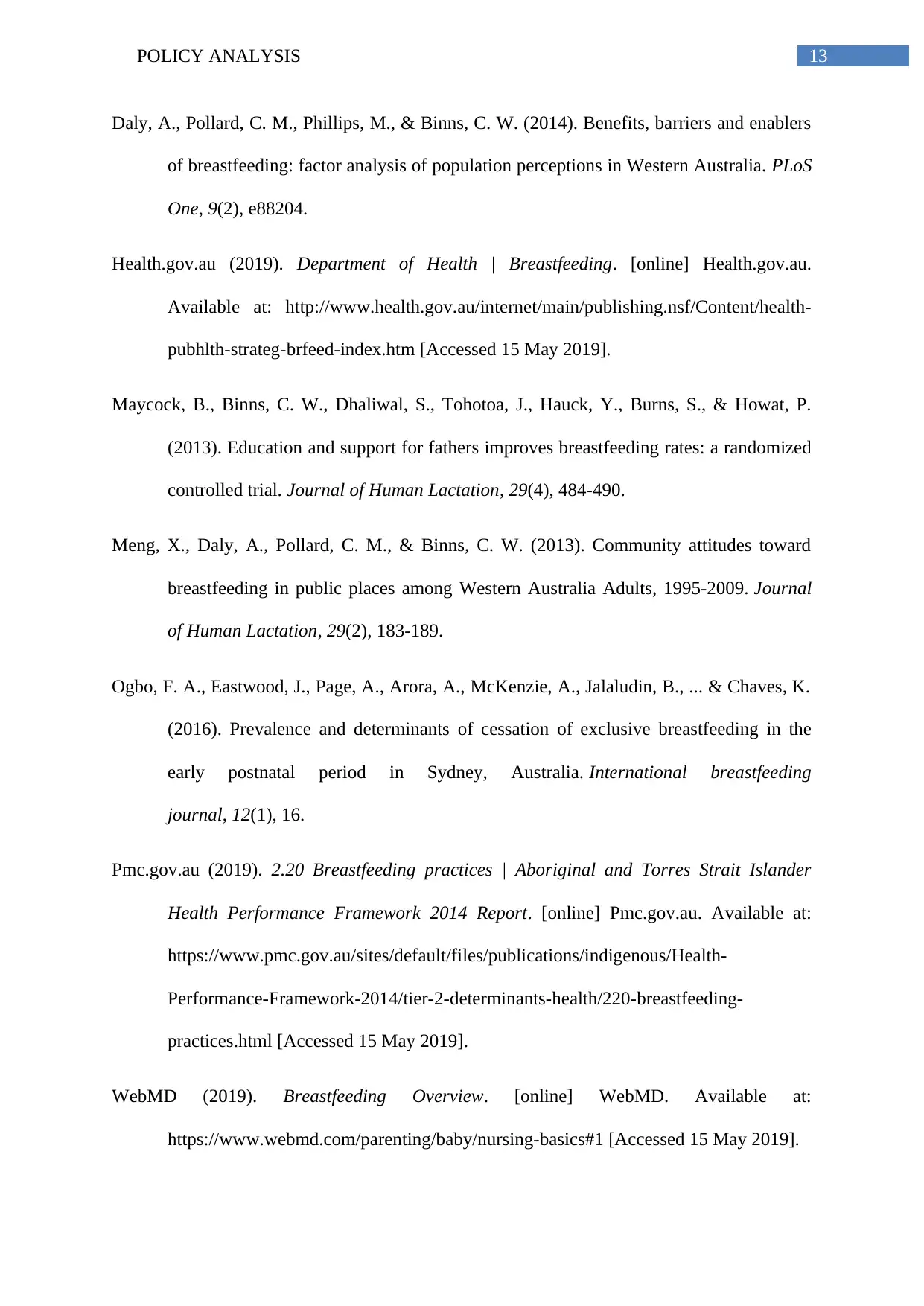
13POLICY ANALYSIS
Daly, A., Pollard, C. M., Phillips, M., & Binns, C. W. (2014). Benefits, barriers and enablers
of breastfeeding: factor analysis of population perceptions in Western Australia. PLoS
One, 9(2), e88204.
Health.gov.au (2019). Department of Health | Breastfeeding. [online] Health.gov.au.
Available at: http://www.health.gov.au/internet/main/publishing.nsf/Content/health-
pubhlth-strateg-brfeed-index.htm [Accessed 15 May 2019].
Maycock, B., Binns, C. W., Dhaliwal, S., Tohotoa, J., Hauck, Y., Burns, S., & Howat, P.
(2013). Education and support for fathers improves breastfeeding rates: a randomized
controlled trial. Journal of Human Lactation, 29(4), 484-490.
Meng, X., Daly, A., Pollard, C. M., & Binns, C. W. (2013). Community attitudes toward
breastfeeding in public places among Western Australia Adults, 1995-2009. Journal
of Human Lactation, 29(2), 183-189.
Ogbo, F. A., Eastwood, J., Page, A., Arora, A., McKenzie, A., Jalaludin, B., ... & Chaves, K.
(2016). Prevalence and determinants of cessation of exclusive breastfeeding in the
early postnatal period in Sydney, Australia. International breastfeeding
journal, 12(1), 16.
Pmc.gov.au (2019). 2.20 Breastfeeding practices | Aboriginal and Torres Strait Islander
Health Performance Framework 2014 Report. [online] Pmc.gov.au. Available at:
https://www.pmc.gov.au/sites/default/files/publications/indigenous/Health-
Performance-Framework-2014/tier-2-determinants-health/220-breastfeeding-
practices.html [Accessed 15 May 2019].
WebMD (2019). Breastfeeding Overview. [online] WebMD. Available at:
https://www.webmd.com/parenting/baby/nursing-basics#1 [Accessed 15 May 2019].
Daly, A., Pollard, C. M., Phillips, M., & Binns, C. W. (2014). Benefits, barriers and enablers
of breastfeeding: factor analysis of population perceptions in Western Australia. PLoS
One, 9(2), e88204.
Health.gov.au (2019). Department of Health | Breastfeeding. [online] Health.gov.au.
Available at: http://www.health.gov.au/internet/main/publishing.nsf/Content/health-
pubhlth-strateg-brfeed-index.htm [Accessed 15 May 2019].
Maycock, B., Binns, C. W., Dhaliwal, S., Tohotoa, J., Hauck, Y., Burns, S., & Howat, P.
(2013). Education and support for fathers improves breastfeeding rates: a randomized
controlled trial. Journal of Human Lactation, 29(4), 484-490.
Meng, X., Daly, A., Pollard, C. M., & Binns, C. W. (2013). Community attitudes toward
breastfeeding in public places among Western Australia Adults, 1995-2009. Journal
of Human Lactation, 29(2), 183-189.
Ogbo, F. A., Eastwood, J., Page, A., Arora, A., McKenzie, A., Jalaludin, B., ... & Chaves, K.
(2016). Prevalence and determinants of cessation of exclusive breastfeeding in the
early postnatal period in Sydney, Australia. International breastfeeding
journal, 12(1), 16.
Pmc.gov.au (2019). 2.20 Breastfeeding practices | Aboriginal and Torres Strait Islander
Health Performance Framework 2014 Report. [online] Pmc.gov.au. Available at:
https://www.pmc.gov.au/sites/default/files/publications/indigenous/Health-
Performance-Framework-2014/tier-2-determinants-health/220-breastfeeding-
practices.html [Accessed 15 May 2019].
WebMD (2019). Breastfeeding Overview. [online] WebMD. Available at:
https://www.webmd.com/parenting/baby/nursing-basics#1 [Accessed 15 May 2019].

14POLICY ANALYSIS
Who.int (2019). WHO | Breastfeeding policy: a globally comparative analysis. [online]
Who.int. Available at: https://www.who.int/bulletin/volumes/91/6/12-109363/en/
[Accessed 15 May 2019].
World Health Organization (2019). Breastfeeding. [online] World Health Organization.
Available at: https://www.who.int/nutrition/topics/exclusive_breastfeeding/en/
[Accessed 15 May 2019].
Who.int (2019). WHO | Breastfeeding policy: a globally comparative analysis. [online]
Who.int. Available at: https://www.who.int/bulletin/volumes/91/6/12-109363/en/
[Accessed 15 May 2019].
World Health Organization (2019). Breastfeeding. [online] World Health Organization.
Available at: https://www.who.int/nutrition/topics/exclusive_breastfeeding/en/
[Accessed 15 May 2019].
1 out of 15
Related Documents
Your All-in-One AI-Powered Toolkit for Academic Success.
+13062052269
info@desklib.com
Available 24*7 on WhatsApp / Email
![[object Object]](/_next/static/media/star-bottom.7253800d.svg)
Unlock your academic potential
© 2024 | Zucol Services PVT LTD | All rights reserved.





